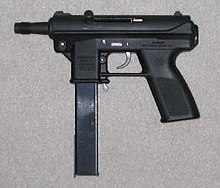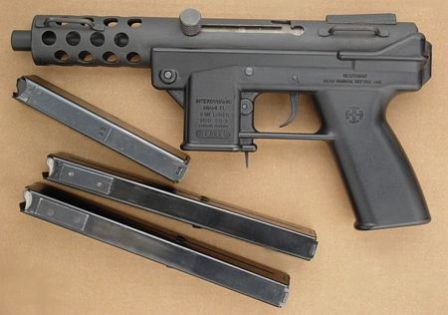KG-9 and TEC DC-9 Assault Handgun
TEC-9
From Wikipedia, the free encyclopedia
(Redirected from Intratec TEC-DC9)
For the rapper, see Tech N9ne.
| TEC-9 / TEC-DC9 / AB-10 | |
|---|---|
 The TEC-DC9M | |
| Type | Handgun |
| Place of origin | Sweden, United States |
| Production history | |
| Designer | George Kellgren |
| Manufacturer | Intratec |
| Produced | 1985–2001 |
| Number built | 257,434 |
| Specifications | |
| Weight | 1.23–1.4 kg depending on model |
| Length | 241–317 mm depending on model |
| Barrel length | 76–127 mm depending on model |
| Cartridge | 9×19mm Parabellum |
| Caliber | 9mm |
| Action | Blowback-operated, semi-automatic |
| Muzzle velocity | 1,181 ft/s (360 m/s) |
| Effective range | 50 m (160 ft) |
| Feed system | 10-, 20-, 32- and 50-round box magazine, 72-round drum magazine |
| Sights | Iron sight |
The Intratec TEC-9 or TEC-DC9 or AB-10 is a blowback-operated semi-automatichandgun, chambered in 9×19mm Parabellum that was designed by Intratec, an American offshoot of Interdynamic AB. The TEC-9 was made of inexpensive molded polymers and stamped steel parts.
Contents
[hide]History[edit]
Swedish company Interdynamic AB of Stockholm designed the Interdynamic MP-9 9mm submachine gun. Intended as an inexpensive submachine gun based on the Carl Gustav M/45 for military applications, Interdynamic did not find a government buyer, so it was brought to US market as an open-bolt semi-automatic KG-9 pistol. Because of this, the ATF forced Interdynamic to redesign it into a closed-bolt system, which was harder to convert to full-auto. This variant was called the KG-99. It made frequent appearances on Miami Vice, where it was legally converted to full-auto by Title II manufacturers.[1][2]
The TEC-9 was produced from 1985 to 1994.[3]
After the Cleveland School massacre, the TEC-9 was in California's list of banned weapons. To circumvent this, Intratec rebranded a variant of the TEC-9 as the TEC-DC9 from 1990 to 1994 (DC standing for "Designed for California"). The most noticeable external difference between the TEC-9 and the later TEC-DC9 is that rings to hold the sling were moved from the side of the gun with the cocking handle, to a removable stamped metal clip in the back of the gun. The TEC-9 and TEC-DC9 are otherwise identical.[citation needed]
The TEC-9 and, eventually, TEC-DC9 variants were listed among the 19 firearms banned by name in the USA by the now expired 1994 Federal Assault Weapons Ban (AWB).[4] This ban caused the cessation of their manufacture, and forced Intratec to introduce a newer model called the AB-10, a TEC-9 Mini without a threaded muzzle/barrel shroud and limited to a 10 round magazine instead of a 20 or 32 round magazine. However, it accepted the high capacity magazines of the pre-ban models.
The weapon was the subject of controversy following its use in the 101 California Street shootings[5][6] and later the Columbine High School massacre.[7][8] California amended its 1989 Roberti-Roos Assault Weapons Control Act (AWCA) later in 1999, effective January 2000, to ban firearms having features such as barrel shrouds.[9][10]
In 2001, the Supreme Court of California ruled that Intratec was not liable for the 1993 California Street attacks.[7] In that same year, the company went out of business and production of the AB-10 model ceased.[7]
See also[edit]
References[edit]
- ^ Muramatsu, Kevin (18 July 2012). The Gun Digest Book of Automatic Pistols Assembly/Disassembly. Iola, Wisconsin: Gun Digest Books. pp. 361–369. ISBN 978-1-4402-3006-6. Retrieved 10 July 2013.
- ^ Peter Harry Brown; Daniel G. Abel (15 June 2010). Outgunned: Up Against the NRA-- The First Complete Insider Account of the Battle Over Gun Control. Free Press. pp. 90–96. ISBN 978-1-4516-0353-8. Retrieved 10 July 2013.
- ^ Phillip Peterson (30 September 2008). Gun Digest Buyer's Guide To Assault Weapons. Iola, Wisconsin: Gun Digest Books. p. 139.ISBN 978-1-4402-2672-4. Retrieved 10 July 2013.
- ^ "Intratec". Violence Policy Center. Retrieved 2010-01-20.
- ^ "California Supreme Court Turns Back Gun Foes in Merrill v. Navegar". Findlaw. Retrieved 2010-01-20.
- ^ "Assault Weapons: The Case Against The TEC-9". Retrieved 2010-01-20.
- ^ a b c "Columbine Gun's Maker Closes Up; Legal Battles Ensnarled Navegar and TEC-9 Pistol". The Washington Post (August 18, 2001).
- ^ "The hidden culprits at columbine". Salon. Retrieved 2010-01-20.
- ^ http://www.ux1.eiu.edu/~cfib/courses/silveira.htm
- ^ http://www.calguns.net/a_california_arak.htm
External links[edit]
- Manual TEC-9 TEC-9 Mini TEC-9 Stainless—Intratec 9 manual (PDF) at Nazarian's Gun Recognition Guide
Interdynamic KG-9 and Intratec TEC DC-9 "assault" pistol (USA)
Interdynamic KG-9 "assault pistol" with 20 and 30 round magazines
Interdynamic KG-9 "assault pistol", bolt locked in open (cocked) position, with 20 round magazine
Prototype Interdynamic MP9 submachine gun
Intratec DC-9 pistol with screw-on barrel extension (fake silencer)
Intratec AB-10, a "post-ban" (post-1994) reincarnation of the Intratec TEC-9 pistol, shown without magazine. The major differences from "pre-1994" TEC-9 pistol are un-shrouded and un-thread barrel, and different markings; the basic design is the same.
| TEC DC-9 | TEC DC-9M | AB-10 | |
| Caliber | 9x19mm Luger/Parabellum | ||
| Weight unloaded | 1400 g | 1230 g | 1260 g |
| Length | 317 mm | 241 mm | 266 mm |
| Barrel length | 127 mm (5") | 76 mm (3") | 76 mm (3") |
| Magazine capacity | 10, 20, 32 or 50 rounds | ||
The Intratec TEC DC-9 "assault pistol", also known as DC-9, TEC-9, or, if manufactured after 1994, as AB-10, bears the dubious distinction of being one of the most widely used "criminal" guns in USA. It was used in several mass murder cases, as well as in unknown, but definitely large number of street fights and other violent crimes. TEC-9 became "famous" for its "evil" appearance, large magazine capacity (which offered significant firepower), and for low price. Unsurprisingly, these features made TEC-9 very popular among various marginal types. For any serious or professional shooter this gun vas of little value - it was too big and heavy to be carried comfortably, it was too unreliable when firing anything but FMJ ammunition, and the accuracy with very crude fixed sights was about marginal.
The TEC-9 design was started in Sweden, when the Interdynamic AB company of Stockholm developed a relatively simple submachine gun. Since Sweden was a poor market for such product, a subsidiary company Interdynamic was established in Miami (Florida, USA), to market Interdynamic guns in USA. As the full-automatic weapons market in USA is very restrictive, the basic submachine gun was converted in semi-automatic only variant, apparently suitable for civilian US market. This semi-automatic pistol, like its submachine gun predecessor, was a simple blowback design, firing from the open bolt. It was designated Interdynamic KG-9. But, sooner than later, US Bureau of Alcohol, Tobacco and Firearms (BATF) found that this semiautomatic pistol can be easily converted back to full automatic, and restricted it manufacture. Interdynamic redesigned the KG-9 into "closed bolt" design by adding the separate striker, and designated it KG-99. About the same time (mid-1980s) the Interdynamic of USA turned into Intratec Firearms, Inc, based in the same city of Miami (Florida). Intratec initially produced the KG-99 under the designation of TEC-9, but about 1989 renamed it into DC-9. With the introduction of the infamous US Assault Weapons Ban in 1994 the Intratec pistols were prohibited for manufacture (but not for ownership, if made before the ban). Intratec subsequently slightly redesigned the basic design, dropping some "assault" features like the threaded barrel, barrel shroud, and forward pistol grip. In this "post-ban" version the pistol was manufactured and sold as AB-10 (AB stands for After Ban). The AB-10 pistols were sold with 10-round magazines, but still could accept both factory and aftermarket high capacity magazines from its predecessors, TEC-9 and DC-9. There were several manufacturers in US, who made copies of DC-9, such as AA Arms, which produced DC-9 look-alike AP-9 pistols. Like originals, AP-9 pistols were of cheap construction and marginal reliability.
The Interdynamics and Intratec pistols are blowback operated, semi-automatic weapons. The major difference between Interdynamic KG-9 and Intratec TEC-9/AB-10 line of pistols is that KG-9 fired from the open bolt, and had a fixed firing pin; the Intratec pistols fire from closed bolt, and have a separate firing pin and a massive striker, which interoperates with the sear. The receivers of all versions are made from steel tube (either carbon or stainless), the frames (or "lower receivers") are made from polymer, integral with pistol grip and magazine housing ahead of the trigger guard. The tubular receiver is hinged to the front of the frame. There is no manual safety. The open-bolt Interdynamic KG-9 pistols featured a special cut, in which the charging handle can be locked when bolt in retracted. The KG-99 and Interdynamic pistols have manual safety built into charging handle - to lock the bolt, one must push the charging handle inward. All pistols are fed from double stack, detachable box magazines; standard magazine capacity was 20 or 32 rounds for pre-ban guns, and 10 rounds for post-ban guns. After-market magazines were offered in various capacities up to 50 rounds. Permanently fixed open sights were not adjustable, and often misaligned. In the pre-ban TEC-9 and DC-9 versions these pistol accepted screw-on barrel extensions, which had purely cosmetic purposes, or silencers (which were illegal in many jurisdictions





No comments:
Post a Comment